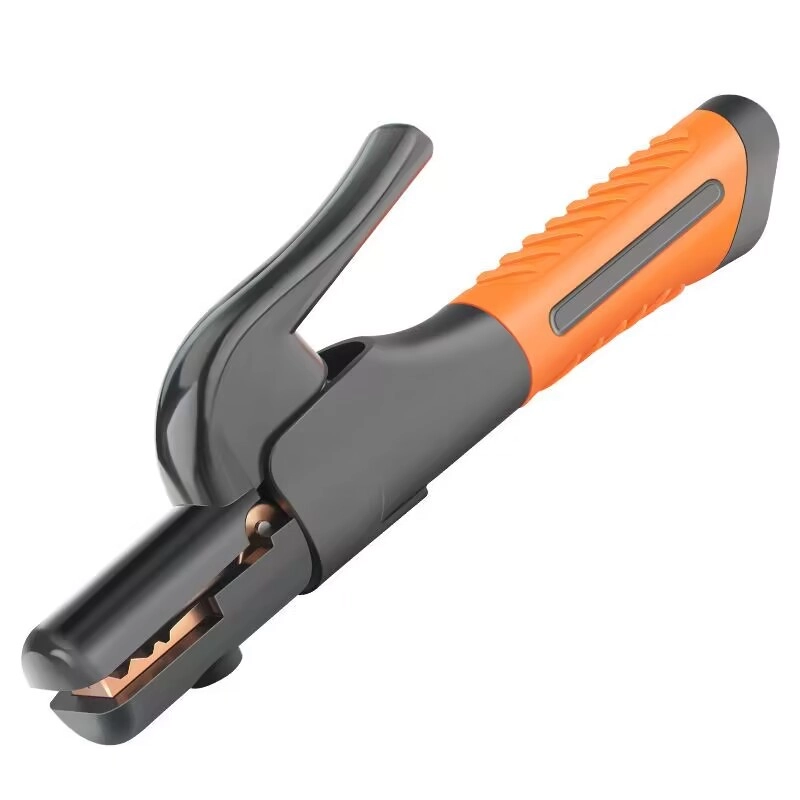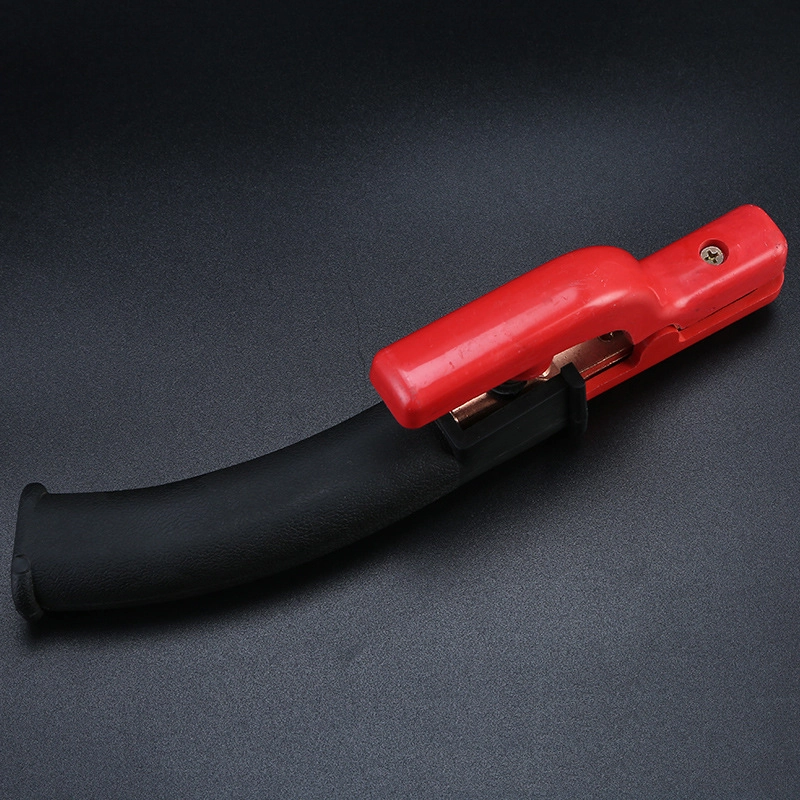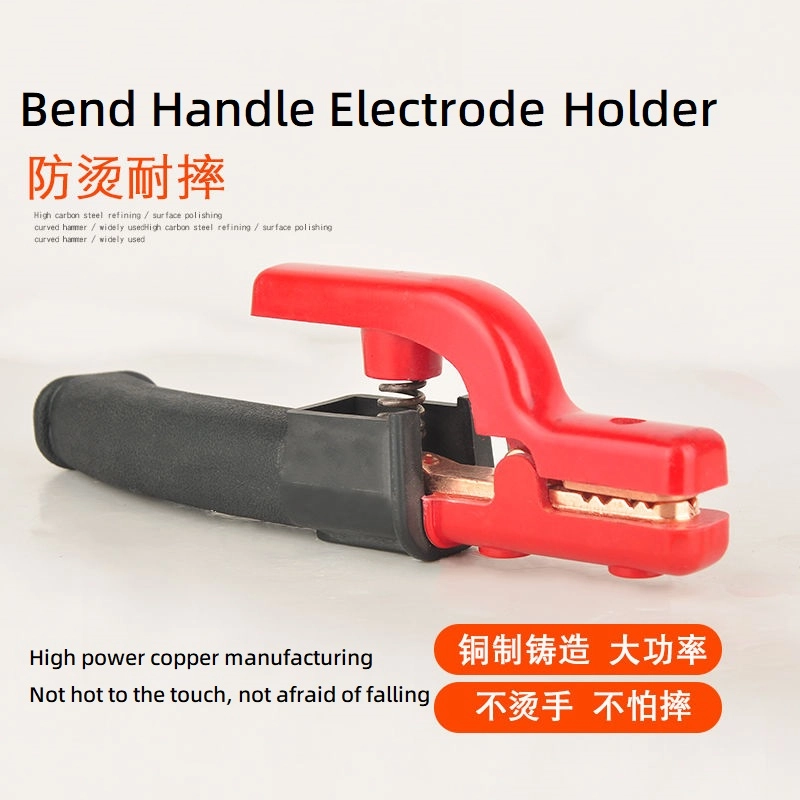Mastering the Weld: A Comprehensive Guide to Welding Electrodes and Electrode Holders
Welcome, fellow welding enthusiasts and procurement professionals! If you're in the business of joining metal, you know that the quality of your weld heavily depends on the tools you use. Among the most critical components are the welding electrode and the electrode holder. This article dives deep into everything you need to know about these essential tools, from understanding different types of electrode materials to selecting the perfect electrode holder for your welding applications. Whether you're a seasoned welder like Mark Thompson, running a large distribution company, or a factory owner like myself, Allen, specializing in welding equipment and protective gear, this guide will provide valuable insights to enhance your welding process, ensure safety, and achieve high-quality results. We'll cover topics like spot welding, resistance welding, and even the importance of an electrode oven. This piece is worth reading because it demystifies the selection process and highlights how the right electrode and electrode holder can significantly impact your operational efficiency and the integrity of your weld projects.
What Exactly is a Welding Electrode and Why is it So Important?
A welding electrode is a coated metal wire that is either a consumable or non-consumable part of the arc welding welding process. Its primary purpose is to conduct current through a workpiece to fuse two pieces of metal together. Think of the electrode as the "pen" that draws the weld. When an electric arc is struck between the electrode tip and the base metal, the intense heat melts both the electrode (if it's consumable) and the workpiece, creating a molten pool. As this pool cools and solidifies, it forms the weld joint. The coating on a consumable electrode serves multiple purposes: it provides a protective gaseous shield around the arc and molten weld pool to prevent atmospheric contamination (like oxygen and nitrogen ingress, which can cause weld defect issues), introduces deoxidizers and scavengers to refine the weld metal, adds alloying elements to enhance the weld's mechanical properties, and helps stabilize the arc. Without a properly selected electrode, achieving a strong, clean, and durable weld is virtually impossible. The electrode directly influences the strength, ductility, and corrosion resistance of the final weld. Therefore, understanding the electrode you're using is fundamental to successful welding.
The importance of the electrode cannot be overstated. It's not just a piece of wire; it's a carefully engineered component that plays a crucial role in the entire welding operation. The composition of the electrode core wire and its coating are meticulously designed for specific welding applications, base metals, and desired weld characteristics. Using the wrong electrode can lead to a host of problems, including poor penetration, excessive spatter, porosity in the weld, cracking, or a weld that doesn't meet the required mechanical strength. For example, an electrode designed for mild steel won't perform well on stainless steel, and vice versa. The diameter of the electrode also matters, as it dictates the amount of current needed and the deposition rate. A larger diameter electrode can lay down more weld metal faster but requires a more powerful welding machine. In essence, the electrode is the heart of the arc welding process, and its correct selection and use are paramount to achieving high-quality welds consistently. This is a key concern for professionals like Mark, who need to ensure the products they distribute meet stringent quality standards.

The selection of an electrode also influences the welding technique and the skill required from the welder. Some electrode types are easier to use in all positions, while others are designed for specific positions like flat or horizontal. The choice of electrode can also impact the post-weld cleanup; some produce a slag that is easily removable, while others might require more effort. As a manufacturer, we understand that providing a diverse range of welding electrodes caters to these varied needs. This ensures that whether our clients are performing intricate fabrication work or heavy structural welding, they have the right electrode for the job. The electrode truly is a cornerstone of the welding world, impacting everything from the initial arc strike to the final properties of the weld.
How Do Different Types of Electrode Materials Affect Your Weld?
The type of electrode material fundamentally dictates the characteristics of the weld. Electrodes are broadly classified based on their core wire composition and the type of coating. For instance, carbon steel electrodes, like the E6010 or E7018, are widely used for welding common structural steels. The "E" signifies an electrode for arc welding, the first two (or three) digits indicate the minimum tensile strength of the deposited weld metal in thousands of pounds per square inch (psi), the next digit indicates the position it can be used in, and the last digit relates to the coating type and welding current. An E7018 electrode, for example, is a low-hydrogen electrode known for producing high-quality, crack-resistant welds on carbon and low-alloy steels. Its coating helps to minimize hydrogen in the weld pool, which is crucial for preventing hydrogen-induced cracking, especially in thicker materials or high-strength steels.
Stainless steel electrodes, such as E308L or E316L, are designed to weld various grades of stainless steel. The "L" denotes low carbon content, which helps prevent carbide precipitation and improves corrosion resistance in the weld. Each stainless steel electrode is alloyed to match the chemical composition of the specific stainless steel grade being welded, ensuring the weld maintains the desired properties like corrosion resistance and strength. Similarly, there are specialized electrodes for cast iron, aluminum, nickel alloys, and hardfacing applications. Each electrode type interacts differently with the base metal and the atmosphere, influencing the final weld chemistry, microstructure, and mechanical performance. Choosing the correct type of electrode material is therefore critical to match the base metal properties and service requirements of the weld. An incorrect electrode can result in electrode incompatibility, leading to a weak or failed weld.
The coating on the electrode also plays a significant part. Rutile coatings (e.g., on E6013 electrodes) produce a smooth arc, low spatter, and an easily removable slag, making them popular for general-purpose welding and sheet metal work. Cellulosic coatings (e.g., on E6010 electrodes) contain a high amount of organic material that produces a forceful arc with deep penetration, ideal for welding in all positions, including vertical down, and for applications like pipe welding. Basic or low-hydrogen coatings (e.g., on E7018 electrodes) produce high-quality, ductile welds with excellent mechanical properties, suitable for critical structural applications. The choice of electrode material and coating, therefore, must be carefully considered based on the base metal, required weld properties, welding position, available welding equipment, and the skill of the welder. This careful selection is a vital part of the welding process.
What is an Electrode Holder and What is its Primary Function?
An electrode holder, often called a "stinger," is a clamping device that the welder uses to hold the electrode in place and conduct the welding current from the welding cable to the electrode. Its primary function is to provide a secure mechanical grip and a reliable electrical connection to the electrode. A good electrode holder ensures that the electrode is held firmly at the desired angle, allowing the welder to manipulate it precisely during the welding operation. It must also efficiently conduct the electrical current without overheating, which is crucial for maintaining a stable arc and consistent weld quality. Electrode holders are essential tools in manual arc welding systems, like Shielded Metal Arc Welding (SMAW).
The design of an electrode holder typically includes an insulated handle is used for the welder to grip safely, protecting them from electric shock, and a metallic jaw or clamp mechanism to hold the electrode. This jaw is usually spring-loaded for easy insertion and removal of the electrode. The electrode holder must be robust enough to withstand the rigors of a welding environment, including heat, spatter, and occasional rough handling. The materials used for the conductive parts of the electrode holder, usually copper or brass alloys, are chosen for their high electrical conductivity and resistance to corrosion. The insulation on the handle and sometimes parts of the jaw is critical for welder safety, preventing accidental contact with live parts.
Furthermore, the electrode holder plays a crucial role in the overall ergonomics and comfort of the welding task. A well-balanced and lightweight electrode holder can reduce welder fatigue, especially during long welding sessions. The ease with which an electrode can be changed also contributes to efficiency. Different electrode holders are designed for various amperage ratings to match the output of the welding machine and the size of the electrode being used. Using an electrode holder with an amperage rating lower than the welding current can cause it to overheat, leading to damage and posing a safety risk. Therefore, selecting the right electrode holder is just as important as choosing the correct electrode.
Are There Different Types of Electrode Holders Available?
Yes, there are several types of electrode holders available, each designed to suit different welding applications, electrode sizes, and welder preferences. The most common type is the insulated twist-type electrode holder and the insulated tong-type (or clamp-type) electrode holder. Twist-type holders secure the electrode by twisting the handle, which tightens a collet around the electrode. They often allow the electrode to be set at various angles. Tong-type or clamp-type electrode holders are typically spring-loaded and operate like a pair of tongs or pliers; the welder squeezes the lever to open the jaws, inserts the electrode, and releases the lever to clamp it. These are very popular due to their simplicity and ease of use when you need to hold the electrode.
Electrode holders are made with different amperage capacities, usually ranging from 150 amps to 600 amps or even higher for heavy-duty applications. It's vital to match the amperage rating of the electrode holder to the welding machine's output and the diameter electrodes being used. An underrated electrode holder will overheat, leading to premature failure, poor current transfer, and potential safety hazards for the welder. Conversely, an overly large electrode holder for low-amperage work can be cumbersome. Specialized electrode holders also exist, such as those designed for underwater welding or those with extra-long handles for reaching difficult spots. The choice among the types of electrode holders available often comes down to the welder's personal preference, the type of welding being performed, and the specific requirements of the welding projects. Some holders are designed for specific electrode diameter ranges.
Another consideration is the material and build quality of the electrode holder. High-quality materials like copper alloys for the conductive parts ensure better current flow and durability. The insulation material should be robust and heat-resistant. Some electrode holders feature replaceable jaws or insulators, which can extend their service life. For procurement officers like Mark Thompson, understanding these different types of electrode holders and their features is crucial for sourcing the right welding equipment that balances performance, durability, and cost for their customers. As a manufacturer’s representative, I always advise considering the specific welding operation when selecting an electrode holder. One popular and reliable option you might consider is the Dongtie 500A 800A Electrode Holder, known for its robust construction.

How Does Conductivity Play a Crucial Role in Electrode and Holder Performance?
Conductivity is a fundamental property that significantly impacts the performance of both the electrode and the electrode holder. For an electrode, especially the core wire, high electrical conductivity is essential to efficiently carry the welding current from the electrode holder to the arc. Poor conductivity in the electrode itself can lead to resistive heating within the electrode, causing it to overheat and potentially leading to inconsistent arc characteristics or even breakage of the electrode. The coating of the electrode also influences the arc stability and current transfer, but the core wire's ability to conduct electricity is paramount for the welding process.
Similarly, the electrode holder must have excellent conductivity in its current-carrying components, primarily the jaws and the connection point for the welding cable. If the electrode holder has poor conductivity due to material choice, corrosion, or a loose connection, it will create resistance. This resistance leads to power loss in the form of heat, causing the electrode holder to become excessively hot. An overheated electrode holder is uncomfortable and unsafe for the welder, can damage the insulation, and leads to inefficient energy use. More critically, poor conductivity can result in a voltage drop at the electrode, leading to an unstable arc, difficulty in starting the arc, and ultimately, a poor-quality weld. Ensuring a clean, tight connection between the electrode and the electrode holder, and between the electrode holder and the welding cable, is vital for maintaining good conductivity and efficient welding.
The materials used in electrode holders are made to maximize conductivity. Copper and brass alloys are preferred for their high electrical conductivity and good mechanical strength. Regular maintenance, such as cleaning the jaws of the electrode holder to remove spatter and oxides, helps maintain optimal conductivity. Any factor that impedes the smooth current flow from the welding machine through the welding cable, electrode holder, and electrode to the workpiece can negatively affect the weld. Therefore, prioritizing components with high conductivity and ensuring all connections are secure and clean is crucial to achieve high-quality welds. This focus on conductivity is a key aspect of designing and manufacturing reliable welding equipment.
What Key Factors Should You Consider When Choosing the Right Electrode?
Choosing the right electrode is a critical decision that directly impacts the success of your welding projects. Several factors to consider include:
- Base Metal Type: The electrode must be compatible with the base metal being welded. For example, use carbon steel electrodes for carbon steel, stainless steel electrodes for stainless steel, and so on. An incompatible electrode can lead to a weak or brittle weld.
- Tensile Strength: The electrode should produce a weld with mechanical properties (especially tensile strength) that match or slightly exceed those of the base metal. The AWS classification system for electrodes (e.g., E7018) helps identify this.
- Welding Position: Some electrodes are designed for all-position welding (flat, horizontal, vertical, overhead), while others are limited to specific positions. The third digit in the AWS classification (e.g., E_ 1 for all positions) indicates this. The chosen electrode must be suitable for the position you'll be welding in.
- Welding Current and Polarity: Electrodes are designed for use with AC, DC positive (DCEP), or DC negative (DCEN) current. Using the wrong current or polarity can affect arc stability, penetration, and weld quality. The manufacturer’s recommendations for the specific electrode should always be followed.
- Thickness and Shape of the Base Metal: Thicker materials generally require electrodes with deeper penetration capabilities or larger diameter electrodes. The joint design also influences electrode selection.
- Service Conditions: Consider the environment the weld will be exposed to (e.g., high or low temperatures, corrosive environments, dynamic loads). The electrode should produce a weld that can withstand these conditions. For example, low-hydrogen electrodes are often required for applications where weld cracking is a concern.
- Skill Level of the Welder: Some electrodes are easier to use and control than others. An E6013 electrode is generally more forgiving for beginners, while an E6010 electrode requires more skill to master.
Understanding these factors helps in selecting an electrode that will produce a sound weld efficiently and economically. It's not just about picking any electrode; it's about picking the right electrode for the specific job. This attention to detail is what distinguishes a high-quality welding operation.
Beyond these primary factors, the condition of the base metal (e.g., clean, rusty, or oily) can also influence the choice of electrode. Some electrodes, like the E6010, are better suited for welding on surfaces that are not perfectly clean due to their forceful arc. The desired appearance of the finished weld bead might also be a consideration, as different electrodes produce different bead profiles and slag coverage. Finally, cost and availability of the electrode are practical considerations, although quality and suitability should never be compromised for price. For Mark Thompson, providing his customers with a good range of electrode options and the knowledge to select the correct one is key to his business's success. The use of electrodes correctly starts with the right selection.

How Do You Select the Best Electrode Holder for Your Welding Machine?
Selecting the best welding electrode holder for your welding machine involves matching the electrode holder's capabilities with the welding machine's output and your typical welding applications. The most important factor is the amperage ratings. The electrode holder must be rated to handle the maximum amperage your welding machine can produce and that you intend to use. Using an undersized electrode holder for the welding current can lead to dangerous overheating, damage to the electrode holder, poor current transfer, and an unstable weld arc. Always check the manufacturer’s specifications for both the welding machine and the electrode holder.
Consider the range of electrode diameter sizes you will be using. Most electrode holders can accommodate a range of electrode diameters, but some are better suited for smaller or larger electrodes. Ensure the electrode holder can securely grip the electrode diameter you typically use. The type of electrode holder (twist or tong/clamp) is often a matter of personal preference for the welder, but also consider the ease of changing the electrode. In high-production environments, an electrode holder that allows for quick and easy electrode changes can improve productivity. Ergonomics and weight are also crucial. A lightweight, well-balanced electrode holder with a comfortable, insulated handle reduces welder fatigue and improves control, especially during extended welding periods. The quality of the insulation is vital for safety, protecting the welder from electric shock.
Finally, look at the build quality and materials of the electrode holder. Electrode holders are made from various materials, but those with copper or brass alloy jaws offer better conductivity and durability. The spring mechanism in clamp-type holders should be strong and durable to maintain a firm grip on the electrode. Some electrode holders have replaceable parts like jaws and insulators, which can be a cost-effective feature in the long run. For heavy-duty applications, a robust electrode holder like the 800-1000A Bending Handle Anti Drop Electrode Holder might be necessary. It's about finding an electrode holder that is safe, efficient, durable, and comfortable for the welder to use with their specific welding machine and tasks.
What is an Electrode Oven and When Should You Use One?
An electrode oven is a specialized heating cabinet designed to store and re-bake welding electrodes, particularly low-hydrogen electrodes like the E7018. The primary purpose of an electrode oven is to keep these electrodes dry and prevent them from absorbing moisture from the atmosphere. Moisture absorption is a significant problem for low-hydrogen electrodes because hydrogen is a major cause of weld cracking, especially in high-strength, low-alloy steels, and thick sections. When a moist electrode is used, the water in the coating breaks down in the arc, releasing hydrogen that can dissolve into the molten weld metal and cause underbead cracking or delayed cracking after the weld cools.
You should use an electrode oven whenever you are working with low-hydrogen electrodes or other types of electrode that are sensitive to moisture, as specified by the electrode manufacturer’s guidelines. New, hermetically sealed containers of low-hydrogen electrodes are typically dry. However, once the container is opened, the electrodes begin to absorb moisture. If they are exposed to the atmosphere for more than a few hours (the exact time depends on the electrode type and ambient humidity), they may need to be re-baked in an electrode oven to drive off the absorbed moisture. The electrode oven maintains the electrodes at an elevated temperature (e.g., 120°C to 150°C or 250°F to 300°F for storage, and higher temperatures for re-baking) to keep them dry and ready for use. Some larger ovens can also perform re-baking cycles at higher temperatures (e.g., 260°C to 430°C or 500°F to 800°F) for a specified duration if electrodes have been exposed to moisture.
Using an electrode oven is a critical quality control measure in many welding applications, particularly in structural steel fabrication, shipbuilding, pressure vessel manufacturing, and pipeline welding, where the integrity of the weld is paramount. Failure to properly store and handle low-hydrogen electrodes can cause welding defects that compromise the safety and performance of the welded structure. Therefore, investing in and correctly using an electrode oven is essential for any operation that relies on high-quality, defect-free welds produced with moisture-sensitive electrodes. This ensures each electrode performs as intended.
What are Common Issues with Electrodes and Electrode Holders and How to Avoid Them?
Several common issues can arise with both electrodes and electrode holders that can affect weld quality and welder safety. For electrodes, moisture absorption in low-hydrogen types is a major concern, leading to weld cracking. This can be avoided by storing them in an electrode oven as discussed. Another issue is electrode contamination from dirt, grease, or rust, which can introduce impurities into the weld pool and cause defects like porosity. Always use clean, dry electrodes. Incorrect electrode selection for the base metal or welding conditions will inevitably lead to poor weld quality. Referencing electrode selection guides and manufacturer’s recommendations is key. Sometimes, an electrode may exhibit erratic arc behavior; this could be due to improper storage, damage to the coating, or an issue with the welding machine settings.
With electrode holders, overheating is a frequent problem. This is often caused by using an electrode holder with an amperage rating too low for the welding current, a loose connection between the welding cable and the electrode holder, or a poor connection between the electrode and the holder's jaw. Regularly inspect and tighten all connections. Worn or damaged insulation on the electrode holder handle is a serious safety hazard, increasing the risk of electric shock. Replace damaged electrode holders or insulators immediately. The jaws of an electrode holder can become worn or coated with spatter over time, leading to a poor grip on the electrode and reduced conductivity. Clean the jaws regularly and replace them if they are excessively worn. A weak spring in a clamp-type electrode holder can also fail to hold the electrode securely.
To avoid these issues, proper maintenance and correct usage are essential. This includes:
- Storing electrodes correctly: Keep them dry, especially low-hydrogen types, using an electrode oven.
- Handling electrodes carefully: Avoid damaging the coating of the electrode.
- Selecting the right electrode and holder: Match them to the job, base metal, and welding machine.
- Regularly inspecting welding equipment: Check electrode holders, cables, and connections for wear or damage.
- Keeping equipment clean: Remove spatter and dirt from electrode holders.
- Ensuring tight connections: This applies to the electrode in the holder and the cable to the holder.
Preventing these issues not only improves weld quality but also enhances welder safety and extends the life of the welding equipment. Ensuring your team is equipped with quality protective gear, such as 14 inch Thick Palm Welding Protective Gloves, is also paramount for safety during any welding operation.
Understanding Electrode Holder Price: Balancing Cost and Quality?
When it comes to electrode holder price, it's tempting to opt for the cheapest option, especially when managing budgets for large operations or distribution. However, the electrode holder price often reflects its quality, durability, and safety features. Cheaper electrode holders might be made from lower-grade materials, have thinner insulation, or less robust clamping mechanisms. While they might save money upfront, they can lead to higher costs in the long run due to frequent replacement, inefficient performance (poor conductivity leading to wasted energy), and increased safety risks for the welder. A defect in an electrode holder can halt an entire welding operation.
A high-quality electrode holder, while potentially having a higher initial electrode holder price, typically offers better conductivity (often using copper or brass alloys), superior insulation that is more heat-resistant and durable, and a stronger, more reliable grip on the electrode. These features contribute to better weld quality, increased welder comfort and safety, and a longer service life for the electrode holder itself. Many premium electrode holders also feature replaceable parts, such as jaws and insulators, which can further reduce long-term costs. It's important to consider the total cost of ownership rather than just the initial electrode holder price. This is a perspective that a decisive procurement officer like Mark Thompson would appreciate when making purchasing decisions that balance cost-effectiveness with safety and durability.
As a factory owner specializing in protective equipment, including welding accessories, I, Allen, always emphasize the value of investing in good quality. The electrode holder price should be weighed against its performance characteristics, safety compliance (e.g., CE marking), and the manufacturer’s reputation. For safety equipment distributors, offering a range of electrode holders at different price points is common, but it's crucial to educate customers on the benefits of choosing a high-quality electrode holder that meets their specific welding needs and safety standards. Ultimately, a well-made electrode holder contributes to more efficient welding, fewer interruptions, and a safer working environment, making it a worthwhile investment despite a potentially higher upfront electrode holder price.
Why is an Adjustable Electrode Holder Often Preferred?
An adjustable electrode holder offers versatility that many welders find highly beneficial. The term "adjustable" in this context often refers to the ability of the electrode holder to grip the electrode at various fixed angles. For example, some electrode holders have multiple grooves or slots in their jaws, allowing the electrode to be positioned at 45°, 90°, or 180° (straight) relative to the handle. This adjustability enables the welder to more comfortably and effectively access joints in different positions—be it flat, horizontal, vertical, or overhead. Instead of contorting their wrist or body into awkward positions to maintain the correct electrode angle, the welder can simply adjust the electrode within the holder.
This feature is particularly useful when welding in confined spaces or on complex assemblies where a fixed-angle electrode holder might limit maneuverability. An adjustable electrode holder can help improve weld quality by allowing the welder to maintain better control over the arc length and travel angle, which are crucial for achieving proper penetration and bead appearance. Furthermore, an adjustable design can reduce welder fatigue, as it allows for a more natural and comfortable hand position during various welding tasks. This ergonomic advantage can lead to increased productivity and consistency over long welding periods.
While not all welding situations demand an adjustable electrode holder, its versatility makes it a popular choice for many professional welders and fabrication shops undertaking a range of welding work. The ability to quickly change the electrode angle without switching electrode holders adds a level of convenience and efficiency. When considering an adjustable electrode holder, it's important to ensure that the adjustment mechanism is robust and maintains a stable contact and secure grip on the electrode at each setting. The primary function to hold the electrode securely should not be compromised by the adjustable feature. Many modern electrode holders successfully combine adjustability with durability and excellent conductivity, making them a valuable tool in the welder's kit. For a comprehensive range of welding supplies, including various types of electrode and electrode holders, you can explore options from trusted suppliers like us at DTlabor.
Key Takeaways for Mastering Your Weld
To ensure you're always achieving the best results in your welding endeavors, remember these crucial points about your electrode and electrode holder:
- Electrode Selection is Paramount: Always choose an electrode compatible with your base metal, considering tensile strength, welding position, and current type. The right electrode is foundational to a quality weld.
- Electrode Holder Amperage Matters: Match your electrode holder's amperage rating to your welding machine and the electrode diameter to prevent overheating and ensure safety.
- Maintain Dry Electrodes: Especially for low-hydrogen types, use an electrode oven to prevent moisture absorption, which can cause welding defect issues like cracking. Each electrode must be kept dry.
- Conductivity is Key: Ensure clean, tight connections for both the electrode and electrode holder to maintain optimal electrical conductivity and efficient welding. This is critical for good current transfer.
- Inspect Regularly: Check your electrode, electrode holder, and cables for wear, damage, or loose connections. Replace damaged welding equipment promptly.
- Prioritize Quality and Safety: While electrode holder price is a factor, don't compromise on the quality of your electrode holder or electrode. High-quality materials and proper insulation are vital for performance and welder safety. Consider investing in reliable safety gear like a Dongtie Flame Retardant Cotton Welding Cap to complement your setup.
- Understand Different Types: Be aware of the various types of electrode holders available and type of electrode options to choose the most suitable ones for your specific welding applications. An adjustable electrode holder can offer significant ergonomic benefits.
By focusing on these aspects, you can significantly improve your welding outcomes, enhance safety, and increase the longevity of your welding equipment. The electrode and electrode holder are more than just tools; they are integral to the art and science of welding.






